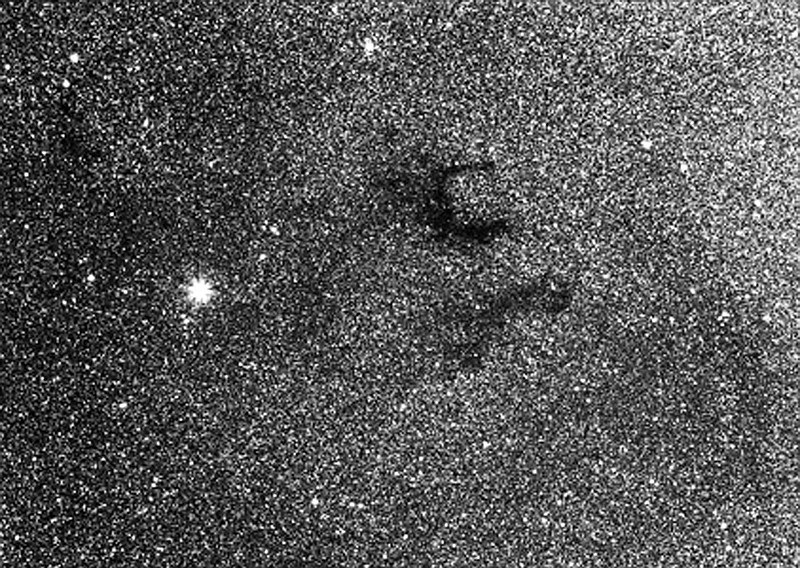With the soon return of seeing the Milky Way conveniently -- you can see it now if you stay up late -- I thought it might be interesting to tell about a kind of nebula occurring throughout the Milky Way's span that usually gets little mention. This kind of nebula is a sort of anti-nebula, not shining on its own at all! This type of nebula is called a "dark nebula."
By about the turn of the 19th century to the 20th century, black and white photographic film had advanced in speed to the point where an astronomer could, with the right kind of camera, photograph dark nebula. Once some good images had been obtained, a debate arose as to whether these dark spots were places in our galaxy where there simply were no stars, or whether there were stars but these stars were somehow obscured by something between the observer and the stars, blocking the view. If the latter were true, what kind of stuff could be blocking the view?
E.E. Barnard, one of America's greatest observational astronomers at this time, had a moment of insight. He was standing on a hillside near Mount Wilson Observatory above the city of Pasadena, Calif., the town where I grew up. The Moon was bright and he watched the very bright Moon with only his eyes. An ordinary cloud drifted in and passed between him and his view of the Moon. This cloud completely blocked his view of the Moon for a few minutes. The Moon then became visible again after the cloud had floated past.
It struck him as amazing that something so diaphanous as a cloud could obscure something that bright! He became convinced that the dark nebula he had photographed earlier with a 10-inch camera he had invented were the result of matter in front of the background stars. These nebulae were actually very large blobs of dust, dense enough to block the stars behind them. Barnard photographed a complete catalog of the dark nebula in the Milky Way that he could see from the northern hemisphere. We know now that Barnard was correct in his understanding the mechanism of dark nebula. His book of images of these nebulae became a classic and made a great reputation for Barnard.
This month, I have included a photo of such a nebula I made with a 300 mm telephoto lens. You can see that it is roughly the shape of a Gothic E -- it became known among amateurs as "Barnard's E-shaped Nebula." It lies right on the Milky Way, near the 1st magnitude star Altair. [The bright star to the left of the E is Altair.] The 'E' is best seen in photos because it is very black and does not stand out except in time exposures. As we later learned, all spiral galaxies have clouds of obscuring dust that form dark nebulae.
May, as noted in last month's column, is one of the best months to see galaxies far beyond the Milky Way. It is also a great time to see Jupiter and Saturn at dawn and it is interesting to see the Moon pass near these two gas giants as it revolves around the Earth. Of course, Jupiter and Saturn lie far behind the Moon which is really rather close to the Earth. Venus will begin to be seen close to the western horizon soon after sunset.
We should have more clear nights as summer comes on. April has been rainy and cloudy -- well and good for new plants budding after winter -- not so great if one wants to see the incredible night sky in its splendor... But -- keep looking!
David Cater is a former faculty member of JBU. Email him at [email protected]. Opinions expressed are those of the author.

